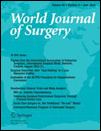Quality of Life After Surgical Treatment of Early Barrett’s Cancer: A Prospective Comparison of the Ivor-Lewis Resection Versus the Modified Merendino Resection
Data were presented in part at the Third EUNE Gastric Cancer International Workshop, 8–9 June 2012 in Cologne, Germany.
Abstract
Introduction
The Merendino (MER) procedure has been evaluated as an alternative to transthoracic esophageal resection (TER) for early stage Barrett’s carcinoma. Apart from reducing morbidity and mortality, improvements concerning postoperative health-related quality of life (HRQL) have been postulated. The aim of our study was to compare HRQL between these procedures.
Materials and methods
Between July 2000 and July 2007, 117 patients with early Barrett’s carcinoma underwent surgery. Patients with tumor recurrence were excluded from the study. HRQL was assessed 1 and 2 years after surgery using the European Organisation for Research and Treatment of Cancer (EORTC) Quality of Life Core Questionnaire (EORTC-QLQ-C30) and the QLQ-OES18 module. Patients recently diagnosed with early Barrett’s carcinoma served as controls. Symptoms that showed a difference of more than ten between the control and the study groups were considered clinically relevant and were tested for significant differences between the study groups using the Mann–Whitney U test (p < 0.05).
Results
The response rates for the questionnaires ranged between 70 and 93 %. In the MER group, more items reflected a clinical relevant impairment of HRQL than in the TER group. Significant complaints in the MER group included nausea/vomiting, appetite loss, local pain, difficulties with social eating, and choking. Moreover, we found a significant restriction concerning global health and emotional and social functioning in this group 1 year after surgery. 2 years postoperatively, hardly any differences between the operative techniques could be detected. The only symptom in favor of the MER procedure was a better dysphagia score postoperatively.
Conclusion
Our study suggests that MER procedure is not superior to subtotal esophagectomy with regard to HRQL.




